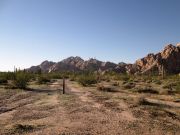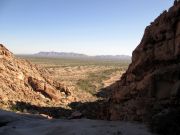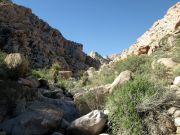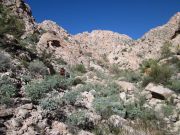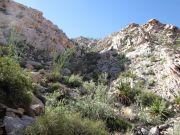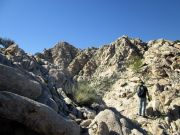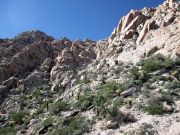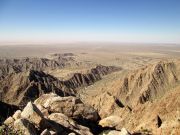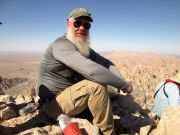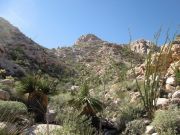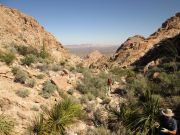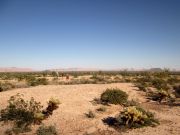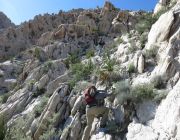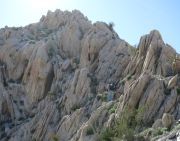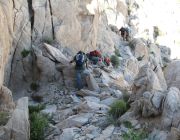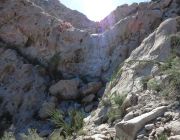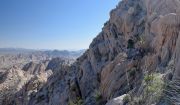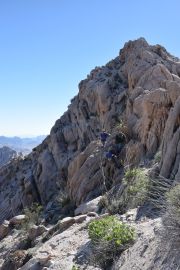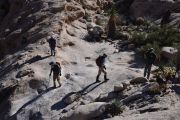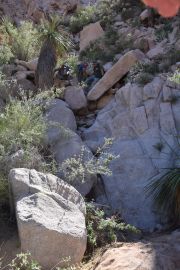
The Mountains of Arizona
• www.surgent.net
|
| Tinajas Altas Peak |
• Highpoint: Tinajas Altas Mountains • Barry M. Goldwater Air Force Range • Yuma County |
|
Date: November 10, 2018
• Elevation: 2,764 feet
• Prominence: 1,724 feet
• Distance: 3.7 miles
• Time: 6 hours and 15 minutes
• Gain: 1,600 feet
• Conditions: Clear, pleasant
• Teammates: Scott Casterlin, Scott Peavy, Matthias Stender, Richard Hensley, Richard Scheibel, John Hamann
Arizona
•
Main
•
AZ P1K
•
PB
•
LoJ
The Tinajas Altas Mountains lie in extreme southern Arizona, the summit being about a mile from the Mexican border. The range features many natural depressions in its rocks and canyons that hold water throughout the year. It was one of few dependable sources of water for the earliest explorers in the region. These depressions are called tanks (tinajas in Spanish), and since they're high up in the mountains, that begets the names "Tinajas Altas".
This trip was organized by John Hamann, and would number seven of us total. Along with John, there was Scott Casterlin, Scott Peavy, Matthias Stender, Richard Hensley and Richard Scheibel. It would be my first time meeting the two Richards, and the first time seeing John in nearly nine years. Having a big team was good. Not that we expect trouble, but there's always that possibility being so close to the border. Also, having lots of people helps with route planning, scouting, and helping old guys like me up tricky parts, that sort of thing.
I only decided to attend earlier in the week, seeing this as a good opportunity to hike this peak, one I would never do alone and not one easy to get to in general. It lies on the Barry Goldwater Air Force Range in Yuma County, 25 miles south of Interstate-8, seemingly in the middle of nowhere. The land down here is open and stunning, and in my few times on the Goldwater, have loved being there.
I left Scottsdale the day before and drove to Wellton, hiking Antelope Hill along the way, then staying the night in Wellton. Matthias picked me up early the next morning, and drove us the 25 miles south along the Camino del Diablo toward the Mexican border and the Tinajas Altas. We arrived about 7:45 a.m., then got a little turned around trying to find everyone else, who had arrived the night before. We followed one road a mile, turned around, then another, and soon found them all encamped at the High Tanks "area". This is an ad-hoc camp site close to some of the high tanks so that one does not need to go far to see them. These tanks are everywhere in the range, but as they say, once you've seen one tinaja alta, you've seen them all. We'd be seeing plenty today.
We convoyed in two vehicles to the "trailhead", an open area along a scant road about a half-mile east of the base of the mountains, elevation about 1,160 feet. The ascent canyon was visible ahead, still in shadows. The mountains are rocky, the rock looking like it melted then reformed into odd, "flow" like shapes. There were interesting voids and other odd formations. It's a gorgeous range, but also a little intimidating. This range does not mess around. Everything is steep and scrambly and brushy.
We started walking at 9 a.m., aiming for the drainage northeast of the summit. Soon, we were in the rocky jumble, and started up the left "banks" of the canyon as one looks up. The rock had good friction but was steep, gaining elevation quickly. It would be impossible to describe the route exactly, other than we scooted around and over obstacles as we found them. The climbing gets steep, and then achieves a big granite dry waterfall (or pour-off). We took a small break here. Beyond this, the slope moderates and the going is easy for a few hundred yards. We passed a number of tinajas on the way up.
The next obstacle was another dry-fall, with a pond of water at its sandy base. We got around it by scooting up a 15-foot wall that sloped back but was exposed. Here, Scott C. helped me with my footing as I was doing this part blindly. I got up it, but did not like this bit. Going down would be interesting, I thought.
Then the canyon's gradient lessened again, and we were soon at a big split. Going left would be steeper but shorter, going right longer and less steep. We went right. The grade was moderate but easy. The brush was thick but not too bad, and we followed game trails at times. This canyon trended west, then bent south again. Up ahead was a long slope aiming for a bump on the ridge above. The slope was rocky and full of brush, and a little loose in places. We all got up this, now on the main ridge, about 2,200 feet elevation.
So far, I had found the going tolerable, with that one tricky dry-fall the only "tough" part up to this point. However, it was consistently brushy, steep and rocky, so that although moving through it was easy, it was tiring. But it was also beautiful, with rock walls in all directions, lots of brush including one called elephant bush (bursera?) with a strong but enjoyable odor to it.
Once at the ridge, the summit massif rose about another 400 vertical feet, looking intimidatingly vertical from our position. There did not appear to be a way up this thing. But up ahead some of the faster members of the group were already working their way up a gully. Us three Scotts were in the rear group. We crossed a small hill and saddle, then up a simple slope to get onto the rocks that lie below the summit cliffs.
Sure enough, what looked vertical was steep, but manageable. We worked up the lower part of the gully, scrambling in many sections, some parts being small cliffs and requiring some agile hand and footwork to get up. Now, we were about 150 feet below the top. The route angles a little left and appears to be a narrow ramp. Here, I started to let the exposure and terrain get to my head a little bit. I had to fight back against my own anxiety. I was so close, I'd be damned if I was going to give up now. But I needed to will up some courage to get moving again. I was not enthusiastic at all about this portion.
There's just one small part of this ramp that is awkward, a five-foot "step" that required more blind hand and foot placement to scramble up. The exposure was severe a fall here could be real bad, possibly fatal. I just did not look down. The last couple dozen feet was just loose slope, and soon, I was on top, with the whole gang. It had taken us about three hours to get here.
The views up here were remarkable. The day was cloudless and blue, with no humidity. We could see endless miles of desert and ranges in all directions. Looking south, we could see the Altar sands in Mexico, plus the border fence and Mexican Federal Highway 2 parallel to it. We could see other ranges such as the Cabeza Prieta, Lechuguilla, Mohawk, Pinta and Gila in Arizona, and Pinacate Peak in Mexico. The top itself was small, with just enough room for the seven of us to sit. The slopes dropped vertically on all sides. We were up here for about twenty minutes.
Here, I will admit I was not a happy camper. I was happy to have summitted, and enjoyed the views. But my mind was entirely consumed with getting down off this perch. I was thinking of nothing except for all those scrambly exposed segments that I had to will myself up, and now wondering how I would do going down. Soon, everyone got their packs on and we started the slow trek down.
That one part just mentioned where the foot placement was done blindly, I was assisted by Richard Hensley, and I appreciated his guidance. I then helped Scott Casterlin who was right behind me. The rest of this section was just plain old-fashioned steep, but going down, I could see my feet better and places to put hands, so it was not too bad, overall. We convened on the slopes below the summit massif.
We elected to follow the canyon below us down, not retrace our route exactly as we had coming up. We descended into the canyon and for the next twenty minutes, hiking down it was fast and easy and fun and delightful. But I knew the fun would end soon, and sure enough it did: we were stopped by a huge pour-off, easily 75 feet tall. Had we gone left instead of right at the split coming up, this is what we would have encountered.
So we were all standing around, wondering what to do. It occurred to me we may have to climb back up to the ridge and go down our other canyon. Matthias and Richard Scheibel took the lead here and found a scrambly bypass that dropped about 80 feet, while the rest of us just sat on the high rocks and watched. No one wanted to start down until we knew it would work. The problem was there was another pour-off visible, but Richard called back that it was easily hikable. With that, the rest of us scooted down the steep rocky slopes into the canyon, now below that massive pour-off, then down the second one, then a long segment of haphazard large boulders and brush. Now we were deep in the main canyon, now back on our ascent route.
There was still that tricky pour-off to descend, the one with the pond at its base. But Richard Hensley had found a weak ledge that allowed us, one at a time, to scoot down, then leap over the water onto the soft sand. That was fantastic we bypassed this and mentally, I felt great. The remainder of the hike went well. It was slow and methodical as we had to work down a few hundred more feet of rock and small cliffs. Finally, we were out of the canyon and back on the desert floor, walking back to the cars. It was a little after 3 p.m., meaning a six-hour round trip. It felt like it had been ten hours.
We drove back to the camp area where we stood around a little bit, but I needed to get back to Wellton, and Scott Casterlin was willing to drive me, so we left while there was still a lot of light. We were back in Wellton about 5 p.m.. I had stashed my car at the hotel (the Desert Motel) where I had stayed. After getting my stuff back into my car and shaking hands, I thanked Scott and he went to get supplies before heading back to the group still encamped at the High Tanks area.
Me, I was exhausted but happy. I drove directly home, even bypassing the Space Age Caf in Gila Bend where I usually eat on trips like these. I was home by 8 p.m..
This peak really pushed me. Some of those scramble sections were above my comfort level and I really needed to muster up courage to get past them. I had to quell any feelings of anxiety. I thank the help of the others to assist me on those two particularly-tricky spots. It was a good team and I appreciated everyone's camaraderie. The only way to improve is to "push the envelope", and I felt I had to here. It was psychologically satisfying to successfully summit and descend this beautiful mountain.
Click here for Scott Peavy's full set of images from this hike. Images from Richard Scheibel's camera:
|
|
